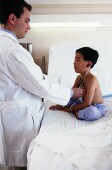
THURSDAY, Nov. 6, 2014 (HealthDay News) — A new pneumococcal vaccine is almost 30 percent more effective than its previous version in preventing hospitalizations of young children for pneumonia, a new study shows.
The vaccine — called PCV13 — protects against 13 strains of pneumococcal bacteria, which is the leading cause of pneumonia in children younger than 5, said study author Dr. Marie Griffin, a professor of medicine and health policy at Vanderbilt University School of Medicine in Nashville, Tenn.
Pneumococcal bacteria can also cause ear and sinus infections, bloodstream infections and meningitis, added Griffin.
Introduced in 2010, the new vaccine improved upon a seven-strain version that had been used since 2000. The introduction of that vaccine led to a more than 40 percent decline in childhood hospitalizations for pneumonia, according to background information in the study.
“Since the vaccine was changed, there’s been another 27 percent decline in pneumonia hospitalizations for children younger than 2,” Griffin said. “This second vaccine is also having a pretty big effect.”
Griffin and her colleagues based their study on hospital data from their home state of Tennessee, which they were able to obtain more quickly than national data. Their findings are published in the Nov. 7 issue of Morbidity and Mortality Weekly Report, issued by the U.S. Centers for Disease Control and Prevention.
Pneumonia hospitalizations in Tennessee now are estimated at four out of every 1,000 children younger than two, “a historically low rate that represents a 72 percent decline” from the rate prior to the introduction of the first vaccine in 2000, according to the study.
Tennessee children younger than 2 experienced about 1,300 fewer pneumonia hospitalizations annually in 2011 and 2012 than in the years prior to pneumococcal vaccine adoption in 2000, the researchers found.
While the study focused on Tennessee, the new vaccine’s benefits have been apparent to doctors in other locales, said Dr. Roya Samuels, a pediatrician at Cohen Children’s Medical Center in New Hyde Park, N.Y.
“We definitely have been seeing decreased rates of hospitalizations of children with pneumococcal pneumonia, and the severity of disease also has declined,” Samuels said. “It definitely has been a huge boon for the pediatric population.”
The vaccine is aimed at the pneumococcal strains “that are the most virulent, the ones most likely to cause disease,” Griffin said.
Childhood deaths from pneumonia are rare, with up to five deaths annually in Tennessee prior to introduction of the vaccine. “It’s an uncommon cause of death, but it’s a very common cause of hospitalization for children,” she said.
The vaccine’s more crucial goal is to prevent bloodstream infections and meningitis, the most serious types of disease caused by pneumococcal bacteria. “Those diseases can kill children, and cause permanent disability if they get meningitis,” Griffin said.
Children receive four shots in the vaccine series, starting at 2 months old. “This is now part of the routine immunization schedule,” she said.
In Tennessee, more than 90 percent of children received their pneumococcal vaccinations on time, according to the study. “This is something if you are taking your child to the doctor, this will definitely be recommended, and most parents get this shot for their children,” Griffin said.
Griffin plans to use state-level data on vaccinations more often in the future. National data can take several additional years to pull together, which makes it difficult to quickly judge a new vaccine’s initial effectiveness.
“We can start looking at these kind of outcomes much more quickly when we use data from the state,” she said. “This will helpfully make us aware if there are any problems, or if the vaccine isn’t doing the job it should be doing.”
More information
For more information on pneumococcal vaccination, visit the U.S. Centers for Disease Control and Prevention.
Copyright © 2025 HealthDay. All rights reserved.

